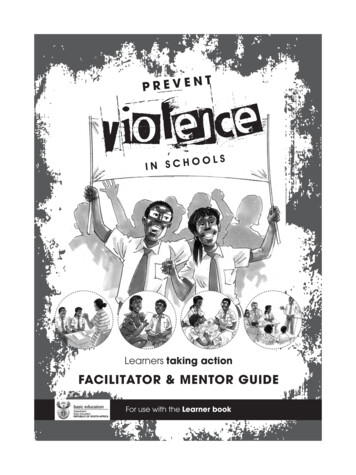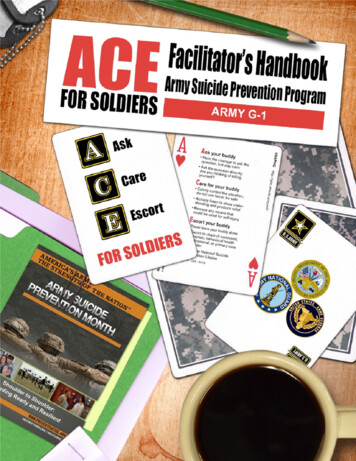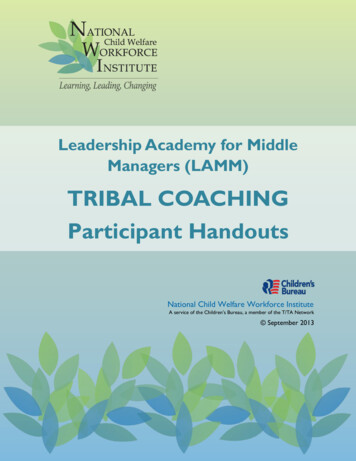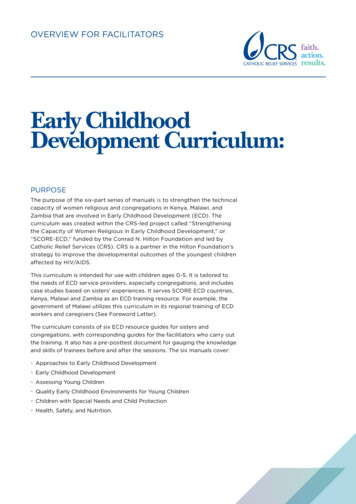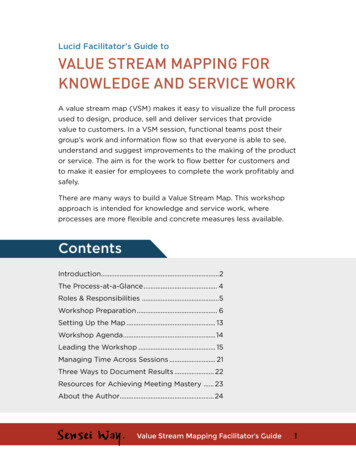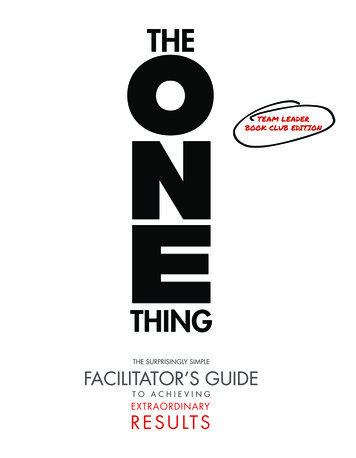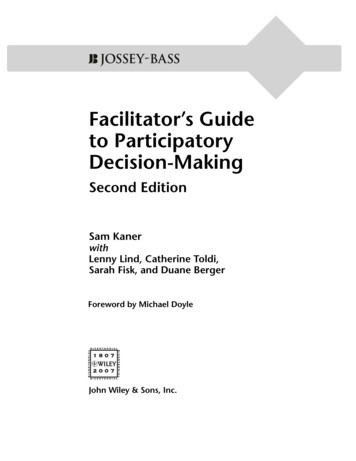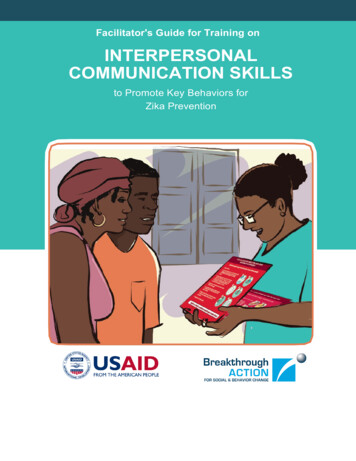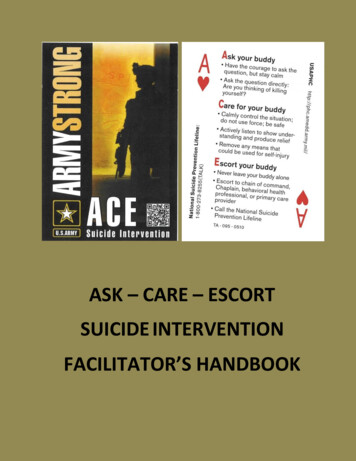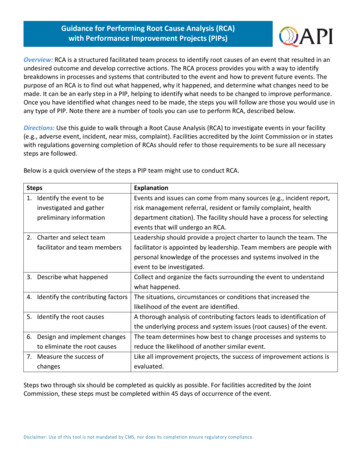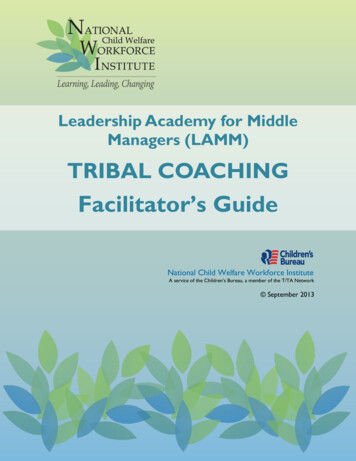
Transcription
Leadership Academy for MiddleManagers (LAMM)TRIBAL COACHINGFacilitator’s GuideNational Child Welfare Workforce InstituteA service of the Children’s Bureau, a member of the T/TA Network September 2013
AcknowledgementsThis publication represents a collaborative effort by the partners of the National ChildWelfare Workforce Institute (NCWWI): University at Albany/SUNY, University of Denver,Fordham University, University of Iowa, University of Maryland, Michigan StateUniversity, University of Michigan, Portland State University, and University of SouthernMaine. Thanks to Nichole Culley and Michelle Zhao for their editorial support. Specialthanks to Mary Wolf, MSW, for her guidance and edits.NCWWI is funded through a cooperative agreement with U.S. Department of Health andHuman Services, Administration for Children and Families, Children’s Bureau, Award No.90CT0145. Special thanks to Randi Walters, Children’s Bureau Project Officer, and RobertLindecamp, Child Welfare Program Specialist (CB/ICF), for their support.Principal AuthorsNancy S. Dickinson, PhD, National Child Welfare Workforce Institute, Project Director,University of MarylandWilliam Wolf, MA, MPA, Leadership Academy for Middle Managers, Tribal Consultant,Portland State UniversityDeborah M. Reed, MSW, Leadership Academy for Middle Managers, Project Manager,Portland State UniversityRecommended CitationNational Child Welfare Workforce Institute. (2013). LAMM tribal coaching facilitator’sguide. Albany, NY: Author.For More InformationVisit the NCWWI website at www.ncwwi.org. 2013 National Child Welfare Workforce Institute, University at Albany, Albany, NY.This document may be reproduced in whole or part without restriction as long as theNational Child Welfare Workforce Institute is credited for the work. Upon request, thecontents of this document will be made available in alternate formats to serve accessibilityneeds of persons with disabilities.The contents of this document are solely the responsibility of the National Child WelfareWorkforce Institute and do not necessarily represent the official views of the Children’sBureau.National Child Welfare Workforce Institutewww.ncwwi.orgA service of the Children’s Bureau, a member of the T/TA Network September 20132
ContentsSchedule . 4Facilitators and Coaches Prework . 6Day 1 . 9Day 2 .40Day 3 .67National Child Welfare Workforce Institutewww.ncwwi.orgA service of the Children’s Bureau, a member of the T/TA Network September 20133
ScheduleFacilitators and Coaches Prework (3:00 p.m. – 7:30 p.m.)Facilitators and Coaches Meeting: Review Agenda, Discuss Roles andResponsibilities; Talking Circle . 3:00 – 5:30 p.m.Welcome Participants, Introductions, and Dinner . 6:00 – 7:30 p.m.Day 1 (8:30 a.m. – 5:00 p.m.)Breakfast . 7:30 – 8:30 a.m.Welcome and Overview of Training . 8:30 – 9:00 a.m.Personal Story of Leading a Change Initiative, Part 1 . 9:00 – 10:00 a.m.Break. 10:00 – 10:15 a.m.Personal Story of Leading a Change Initiative, Part 2 . 10:15 – 11:00 a.m.Review of NCWWI Leadership Model and Tribal Perspective toCreate Change . 11:00 a.m. – noonLunch . noon – 1:00 p.m.World Café Discussion. 1:00 – 2:30 p.m.Break. 2:45 – 3:00 p.m.Ice Breaker . 3:00 – 3:05 p.m.World Café Discussion (continued) . 3:05 – 4:00 p.m.Large-Group Discussion . 4:00 – 4:15 p.m.Personal Journals . 4:15 – 4:45 p.m.One-Word Debrief and Adjourn . 4:45 – 5:00 p.m.Day 2 (8:30 a.m. – 5:00 p.m.)Breakfast . 7:30 – 8:30 a.m.Reflections and Review of the Day . 8:30 – 8:45 a.m.Adaptive Leadership in Tribal Child Welfare . 8:45 – 9:15 a.m.Adaptive Leadership: Small-Group Coaching . 9:15 – 10:15 a.m.Break. 10:15 – 10:30 a.m.Addressing Challenges . 10:30 – 11:45 a.m.Lunch . 11:45 a.m. – 12:45 p.m.Trauma and Leadership . 12:45 – 1:30 p.m.Strategies for Change . 1:30 – 1:45 p.m.National Child Welfare Workforce Institutewww.ncwwi.orgA service of the Children’s Bureau, a member of the T/TA Network September 20134
Talking Circle . 1:45 – 2:45 p.m.Break. 2:45 – 3:00 p.m.Icebreaker . 3:00 – 3:05 p.m.NCWII Leadership Principles . 3:05 – 4:15 p.m.Personal Journals . 4:15 – 4:45 p.m.One-Word Debrief and Adjourn . 4:45 – 5:00 p.m.Day 3 (8:30 a.m. – 3:30 p.m.)Breakfast . 7:30 – 8:30 a.m.Agenda and Objectives; Reflections and Review of Previous Day. 8:30 – 8:45 a.m.Leading for Sustainable Systems Change . 8:45 – 10:00 a.m.Break. 10:00 – 10:15 a.m.Change Initiative Revisions . 10:15 – 11:00 a.m.Culturally Responsive Logic Model. 11:00 a.m. – noonLunch . noon – 1:00 p.m.Change Initiative Action Plans . 1:00 – 2:15 p.m.Parking Lot . 2:15 – 2:20 p.m.Evaluation . 2:20 – 2:30 p.m.Closing the Circle . 2:30 – 3:30 p.m.Adjourn .3:30 p.m.National Child Welfare Workforce Institutewww.ncwwi.orgA service of the Children’s Bureau, a member of the T/TA Network September 20135
Facilitators and Coaches PreworkAgenda Facilitators and coaches meetingoReview LAMM tribal coaching agendaoDiscuss roles and responsibilitiesoTalking circleWelcome participantsoIntroductionsoDinnerPreparation Slide 1 EquipmentoComputer/projector for slidesoScreen and LCD projector with sound system to attach to laptopoMicrophone/PA systemoPower/extension cords3:00 – 5:30 p.m.Facilitators and Coaches Meeting (2.5 hours)Facilitators and coaches meet to review LAMM Tribal Coaching agenda and discuss rolesand responsibilities.Conduct a talking circle to facilitate centering by the facilitators and coaches. Describe theprocess as a culturally-responsive format for check-ins. The intent of this exercise is to helpfacilitators and coaches focus on LAMM Tribal Coaching while putting personal, work, andtravel issues aside.Ask facilitators and coaches to sit in a circle. No one should be outside of the circle—it isvital that everyone participates.Explain that the circle is sacred. Everyone in the circle has the right to be there, andeveryone has the right to express how they feel and think. What is said in the circle stays inthe circle. The circle is created as a place where everyone can feel safe. The purpose of thiscircle is to give everyone an opportunity to talk about the identified topic. In this instance,it is used as a way of beginning to know each other, acknowledging what is going on in eachother’s lives, helping others understand what they are dealing with outside of the training,and beginning to unify the cohort as a sacred circle.Explain that an eagle feather will be passed around (when tribal participants facilitate atalking circle in their communities, they may choose to use another object specific to theirNational Child Welfare Workforce Institutewww.ncwwi.orgA service of the Children’s Bureau, a member of the T/TA Network September 20136
community). Only the individual who has the eagle feather has the opportunity to speak,while others listen. Ask for clarifying questions before you begin.Begin the talking circle by sharing what is relevant in your life that will help othersunderstand who you are and what stressors may hinder the focus on the training. Thenpass the eagle feather to the individual on your left. After each person has had anopportunity to speak, thank everyone for their openness—this will help set the foundationof trust and teamwork in the work ahead.Close the talking circle with a prayer or meditation.6:00 – 7:30 p.m.Welcome Participants, Introductions, and Dinner (1.5 hours)Welcome participants and show slide 1: Participant Introductions.Ask each participant to introduce themselves to the group by providing the information onthe slide.National Child Welfare Workforce Institutewww.ncwwi.orgA service of the Children’s Bureau, a member of the T/TA Network September 20137
Ask for a show of hands of those who attended the LAMM Training: More than one year ago One year ago or less Six months ago or lessAsk for a show of hands of those who have implemented a portion of their tribal childwelfare agency’s change initiative.Tell participants there is a richness of expertise within the room.Encourage participants to use each other as resources throughout the next three days, andwhen they go back home to their tribal communities.National Child Welfare Workforce Institutewww.ncwwi.orgA service of the Children’s Bureau, a member of the T/TA Network September 20138
Day 1Agenda OpeningoHousekeepingoWorking agreementsoPersonal journals Overview of LAMM Tribal Coaching Personal story of leading a change initiative Break Personal story of leading a change initiative (continued) Review of NCWWI Leadership Model and tribal perspective to create change Lunch World Café discussion Break World Café discussion Personal journals One-word debrief and adjournPreparation Slides 2 – 28 Materials oNametagsoNameplates for tables with preassigned partnersoPersonal journalsoNotepadsoPensoWorld Café materialsoFour tablesoMarkers and sticky flipchart paper for each tableoFlipchart paper on each table with a keyword and questionsEquipmentoComputer/projector for slidesoScreen and LCD projector with sound system to attach to laptopNational Child Welfare Workforce Institutewww.ncwwi.orgA service of the Children’s Bureau, a member of the T/TA Network September 20139
oMicrophone/PA systemoPower/extension cordsFacilitator/Coach Prework Make nametags and nameplates for the tables in advance of the training. Pair upparticipants with differing backgrounds by placing the same colored dot on the backof each pair’s nameplates. For example, pair up people from different states, or pairsomeone who has been working on their change initiative for a year with someonewho recently finished the LAMM. Place the nameplates on the tables beforeparticipants arrive. Each nametag should include tribal affiliation and name of the tribal child welfareagency. Before the training begins, identify someone in the cohort and privately ask if she orhe would offer an opening prayer, meditation, or song. Display the preselected quote from an American Indian/Alaska Native leader on theprojector before participants arrive.World Café Prework (After-Lunch Session) Set up enough tables to accommodate 7 to 8 participants per table. Place the name of the quadrant and center of the model and questions on each table. Place markers and sticky pad flipchart paper on each table. Write the quadrant and center of model and related questions on flipchart paper oneach table.National Child Welfare Workforce Institutewww.ncwwi.orgA service of the Children’s Bureau, a member of the T/TA Network September 201310
8:30 – 9:00 a.m.Welcome and Overview of Training (30 minutes)Show slide 2: Leadership Academy for Middle Managers Tribal Coaching.Greet and welcome tribal child welfare managers to the LAMM Tribal Coaching.National Child Welfare Workforce Institutewww.ncwwi.orgA service of the Children’s Bureau, a member of the T/TA Network September 201311
Show slide 3: National Child Welfare Workforce Institute (NCWWI) Purpose.Briefly review the purpose of NCWWI.National Child Welfare Workforce Institutewww.ncwwi.orgA service of the Children’s Bureau, a member of the T/TA Network September 201312
Show slide 4: Goal of the Leadership Academy for Middle Managers (LAMM).Briefly review the goal of the Leadership Academy for Middle Managers.National Child Welfare Workforce Institutewww.ncwwi.orgA service of the Children’s Bureau, a member of the T/TA Network September 201313
Show slide 5: Goal of LAMM Tribal Coaching.Review the goal of LAMM Tribal Coaching.Tell participants that the next few days are built on the LAMM curriculum and areprovided in a coaching format to support their ability to apply what they learned in theLAMM back at their agencies and continue to build their capacity for systems change.National Child Welfare Workforce Institutewww.ncwwi.orgA service of the Children’s Bureau, a member of the T/TA Network September 201314
Show slide 6: Tribal Coaching Participant Objectives.Remind participants that they have this list of objectives in their handouts.National Child Welfare Workforce Institutewww.ncwwi.orgA service of the Children’s Bureau, a member of the T/TA Network September 201315
Show slides 7 and 8: Agenda: Day 1.National Child Welfare Workforce Institutewww.ncwwi.orgA service of the Children’s Bureau, a member of the T/TA Network September 201316
Show slide 9.Read the quote as you transition to the Opening.OpeningThe individual you selected in advance offers a prayer, meditation, or song.HousekeepingGive directions to the restrooms and rooms where breakfasts and lunches will occur,including the mealtimes and break times. Point out that participants may take care of theirpersonal needs at any time.Inform participants that lunch and snacks are provided but dinners are not. Direct peopleto the papers or brochures that identify local restaurants and nearby shopping andattractions.National Child Welfare Workforce Institutewww.ncwwi.orgA service of the Children’s Bureau, a member of the T/TA Network September 201317
Working AgreementsShow slide 10: Working Agreements.Tell participants that the group will come up with basic ground rules they will agree tokeep during the training.National Child Welfare Workforce Institutewww.ncwwi.orgA service of the Children’s Bureau, a member of the T/TA Network September 201318
Show slide 11: Four Agreements.These could be the first ground rules participants agree to. Explain:Be impeccable with your word. Speak with integrity. Say onlywhat you mean. Avoid using the word to speak against yourself or togossip about others. Use the power of your word in the direction oftruth and love.Don’t take anything personally. Nothing others do is because ofyou. What others say and do is a projection of their own reality, theirown dream. When you are immune to the opinions and actions ofothers, you won’t be the victim of needless suffering.Don’t make assumptions. Find the courage to ask questions and toexpress what you really want. Communicate with others as clearlyas you can to avoid misunderstandings, sadness, and drama. Withjust this one agreement, you can completely transform your life.Always do your best. Your best is going to change from moment tomoment; it will be different when you are healthy as opposed to sick.National Child Welfare Workforce Institutewww.ncwwi.orgA service of the Children’s Bureau, a member of the T/TA Network September 201319
Under any circumstance, simply do your best and you will avoid selfjudgment, self-abuse, and regret.Ask participants for additional working agreements they want observed during thetraining. If no one suggests them, add:1.Put mobile phones on vibrate2.Carry out texting and emailing only during breaks3.Decide how time will be handled (start and end on time, honor breaks, etc.)Personal JournalsTell participants they will be given time each day to write down ways they can enhancetheir tribal agencies’ change initiatives, based upon their learning of the day. It can includeideas generated by the information presented as well as lessons learned in coaching andsuccessful strategies shared by their colleagues.Remind participants that individual coaching will also be available throughout the LAMMTribal Coaching.Show slide 12: Day 1 Participant Objectives.Briefly review the objectives.National Child Welfare Workforce Institutewww.ncwwi.orgA service of the Children’s Bureau, a member of the T/TA Network September 201320
9:00 – 10:00 a.m.Personal Story of Leading a Change Initiative, Part 1 (1 hour)Show slide 13: Personal Story of Leading a Change Initiative.For this small-group exercise, everyone is seated next to their preassigned partner. Eachset of partners has the same color dot on the back of their nameplate.Ask participants to share with their partners their leadership story as it pertains to theirtribal child welfare agency’s change initiative. Use the five items on slide 13 as a guide.Each partner will have 25 minutes to share, for a total of 50 minutes.Inform participants that you will let them know when: The first person has 1 minute left It’s time to switch so the other partner can share their story The second person has 1 minute leftNational Child Welfare Workforce Institutewww.ncwwi.orgA service of the Children’s Bureau, a member of the T/TA Network September 201321
10:00 – 10:15 a.m.Break (15 minutes)Show slide 14: Break.National Child Welfare Workforce Institutewww.ncwwi.orgA service of the Children’s Bureau, a member of the T/TA Network September 201322
10:15 – 11:00 a.m.Personal Story of Leading a Change Initiative, Part 2 (45 minutes)Show slide 15: Personal Story of Leading a Change Initiative (Part 2).Provide directions for the small-group activity:Each set of partners will have 10 minutes to share their changeinitiative leadership stories within their small groups.Each partner takes turns responding to the three questions on slide15.As time permits within the 10-minute period, others in the smallgroup may ask clarifying questions.This process is repeated until all sets of partners have had anopportunity to share.At the end of the activity, bring participants’ attention back to the larger group. Ask forthemes heard during this exercise. Depending on time remaining, call on up to threeparticipants to share.National Child Welfare Workforce Institutewww.ncwwi.orgA service of the Children’s Bureau, a member of the T/TA Network September 201323
11:00 – 12:00 p.m.Review of the NCWWI Leadership Model Quadrants and Pillars and a Look at theLeadership Model from a Tribal Perspective (1 hour)11:00 – 11:10 a.m.—NCWWI Leadership Model (10 minutes)Show slide 16: NCWWI Leadership Model.Briefly review Leadership Model quadrants and pillars, asking managers to think back totheir experience with LAMM residential training. In each quadrant, ask for “ahas” fromprior training. Explain:Leading Change involves the ability to bring about strategic change,both within and outside the organization, to meet organizational goals.Inherent to this domain is the ability to establish an organizationalvision and to implement it in a continuously changing environment.Leading in Context involves the ability to build collaborativesinternally and with other federal agencies, state and localgovernments, tribal organizations, and nonprofit and private-sectororganizations to achieve common goals.National Child Welfare Workforce Institutewww.ncwwi.orgA service of the Children’s Bureau, a member of the T/TA Network September 201324
Leading People involves the ability to lead people toward meetingthe organization’s vision, mission, and goals. Inherent to this domainis the ability to provide an inclusive workplace that fosters thedevelopment of others, facilitates cooperation and teamwork, andsupports constructive resolution of conflicts.Leading for Results involves the ability to meet organizationalgoals and service expectations. Inherent to this domain is the abilityto make decisions that produce high-quality results by applyingtechnical knowledge, analyzing problems, and calculating risks.Self-managing and regenerative fundamental competencies arefoundational for success in each of the domains.Leadership pillars: Adaptive—Learning new ways for dealing with challenges Collaborative—Community engagement Distributive—Leadership encouraged and enacted at allorganizational levels Inclusive—Collective process to promote inclusion Outcome-Focused—Meeting organizational and professionalgoalsBalance is external and internal, flexibility and control.11:10 – 11:50 a.m.—Small-Group Coaching Activity on Tribal Perspective to Create Change(40 minutes)Introduce the small-group coaching activity:Over the next 40 minutes, coaches will be leading a discussion withtheir small groups.National Child Welfare Workforce Institutewww.ncwwi.orgA service of the Children’s Bureau, a member of the T/TA Network September 201325
Show slide 17: Leading Change Questions.At each table, coaches ask the whole group—not each individual—to respond to thecoaching questions on slide 17.11:50 – noon—Debrief of Small-Group Coaching Activity (10 minutes)After 40 minutes, bring the participants’ attention back to the larger group. Ask coaches tobriefly report on themes.National Child Welfare Workforce Institutewww.ncwwi.orgA service of the Children’s Bureau, a member of the T/TA Network September 201326
Noon – 1:00 p.m.Lunch (1 hour)Show slide 18: Lunch.National Child Welfare Workforce Institutewww.ncwwi.orgA service of the Children’s Bureau, a member of the T/TA Network September 201327
1:00 – 2:30 p.m.World Café Discussion (1.5 hours)Show slide 19: Welcome to the World Café.The World Café helps participants define priorities for their tribal child welfare agency’schange initiative goals. Describe the World Café method.Facilitator note: Drawing on integrated design principles, the World Café methodology isa simple, effective, and flexible format for hosting a large-group dialogue.National Child Welfare Workforce Institutewww.ncwwi.orgA service of the Children’s Bureau, a member of the T/TA Network September 201328
Show slide 20: The World Café: Principles for Hosting Conversations That Matter.Five components comprise the basic model:Setting. Creates a “special” environment, most often modeled after a café.Welcome and introduction. Begin with a warm welcome and an introduction to theWorld Café process, setting the context, sharing the café etiquette, and putting participantsat ease.Small-group rounds. The process includes three 20-minute rounds of conversation for thesmall group seated around a table. At the end of each round, each member of the groupmoves to a different table. Coaches remain at their tables as Wisdom Keepers who welcomethe next group and briefly fill them in on what happened in the previous round.Questions. Each round starts with one or more questions related to the NCWWILeadership Model’s four quadrants.Harvest. After or between the small-group rounds, invite participants to share insights orother results from their conversations with the rest of the group. These results are reflectedvisually on flipcharts, as recorded by coaches.National Child Welfare Workforce Institutewww.ncwwi.orgA service of the Children’s Bureau, a member of the T/TA Network September 201329
Initial InstructionsAsk participants to count off from 1 to 5 and repeat until everyone has a number. All thenumber ones should go to table 1, all the number twos to table 2, etc., for all five tables. Tellparticipants they will not be able to participate at every table.Show slide 21: World Café Guidelines.Explain the guidelines shown on slide 21.Facilitator note: The coach’s role is to reinforce instructions, guide discussion (as needed)to document insights and themes on a flipchart, and be the Wisdom Keeper.Explain that this round-robin activity includes coaching questions related to the NCWWILeadership Model quadrants and that it provides an opportunity for all voices to be heard.Use this timing: 1:10—First discussion 1:30—Transition to a new table 1:35—Second discussion 1:55—Transition to a new tableNational Child Welfare Workforce Institutewww.ncwwi.orgA service of the Children’s Bureau, a member of the T/TA Network September 201330
2:00—Third discussion 2:20—Transition back to the large groupWorld Café Table 1—Quadrant: Leading ChangeThe role of the leader in this quadrant is to bring about strategic change, both within andoutside the organization, to meet organizational goals. This involves the competencies ofcreativity and innovation, flexibility, external awareness, the ability to build a sharedvision, and the ability to implement the vision in a continuously changing environment. What competencies of leading change are most important to the success of the tribalchild welfare agency’s change initiative? How do you gain and hold a vision for the change initiative that will lead to a betterfuture? What challenges does your agency face related to leading change? What solutions for leading change have you used successfully?World Café Table 2—Quadrant: Leading in ContextThe role of the leader in this quadrant is to build collaborative relationships internally andexternally to achieve common goals. This involves the competencies of being politicallysavvy, advocacy, partnering with the community, and using influence and negotiating skillsto build consensus to accomplish goals. What competencies of leading in context are most important to the success of thetribal child welfare agency’s change initiative? How does leadership in this quadrant contribute to sustainability of the work oftribal child welfare agencies and sustainability in American Indian/Alaska Nativetribes in general? What alliances will you need to develop (or have developed) to move this new workforward? Which relationships do you need to strengthen to implement and sustain this changeinitiative?World Café Table 3—Quadrant: Leading PeopleThe role of the leader in this quadrant is to lead staff toward meeting the organization’svision, mission, and goals. Competency includes the ability to provide an inclusiveworkplace that fosters the development of others, facilitates cooperation and teamwork, andsupports constructive conflict resolution. What competencies of leading people are most important to the success of a tribalchild welfare agency’s change initiative? What are your strengths in leading people that enable implementation of thischange initiative? How will your agency’s initiative contribute to a tribal environment in whichcultural and other differences are appreciated? What challenges does your agency face related to leading people?National Child Welfare Workforce Institutewww.ncwwi.orgA service of the Children’s Bureau, a member of the T/TA
Leadership Academy for Middle Managers (LAMM) TRIBAL COACHING Facilitator's Guide . National Child Welfare Workforce Institute A service of the Children's Bureau, a member of the T/TA Network
